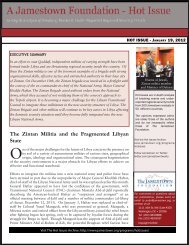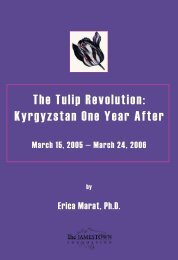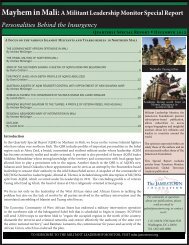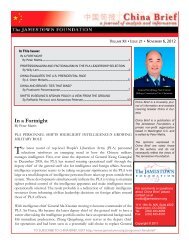By Brian Glyn Williams - The Jamestown Foundation
By Brian Glyn Williams - The Jamestown Foundation
By Brian Glyn Williams - The Jamestown Foundation
Create successful ePaper yourself
Turn your PDF publications into a flip-book with our unique Google optimized e-Paper software.
<strong>The</strong> Tatars' ferocity in battle was legendary and it was rare that a Tatar gave himself up in battle. Russia's<br />
armies were reluctant to confront these warriors on the field even as late as 1591. Massa's description of a<br />
Tatar attack on Moscow in that year is a vivid testimony to the Khan's ability to launch a frontal assault<br />
against even the most protected of sites.<br />
<strong>The</strong> two great armies came face to face. On the first day they did not move. On the<br />
second day, two Tatar horsemen advanced to the foot of the Muscovite entrenchment. <strong>The</strong><br />
Muscovites began firing their heavy artillery on them, though to no good purpose. <strong>The</strong>n<br />
hundreds followed by thousands of Tatars moved up, falling like hail upon the<br />
entrenchment and firing arrows in such numbers that the sky was dark with them. 172<br />
Contemporaries were frequently impressed by the Tatars' archery and, in many respects the Tatars' reflex<br />
compound bow (known in the West as a Turkish bow), was superior in battle to the firearms of their<br />
opponents. <strong>The</strong> bow was powerful enough to shoot an arrow several hundred yards and could even<br />
pierce armor. 173 A Turkish ambassador to London is reported to have fired an arrow 482 yards with such a<br />
bow and then complained that the bow was weak. 174<br />
During the Long War, the Habsburg General Giorgio Basta found the Tatars' bow to be especially<br />
destructive and was eventually forced to arm his troops with extra long arquebuses to overcome his<br />
opponent's superiority. Kortepeter remarks that the "<strong>The</strong> Tatar bow, in other words, still had a longer<br />
range than the ordinary arquebus." 175<br />
<strong>The</strong> Tatar bow also had the advantage of being more accurate than the firearms of the time. One<br />
observer noted that "Tatar chieftains shoot so well that birds are afraid to fly." 176 <strong>The</strong> bow had the added<br />
benefit of being lighter and much easier to reload than an arquebus or musket. Brodie claims that "In<br />
1600 it still took ten to fifteen minutes to load and fire an arquebus," while a Tatar could notch an arrow in<br />
a matter of seconds. 177<br />
Even the advent of the musket, which had a longer range than the arquebus, gave the Tatars' sedentary<br />
opponents few advantages for it was heavier and clumsier than the arquebus. It can be seen that Barker's<br />
comment on the inferiority of the lightly equipped Tatar raiders ’ lack of firearms is not necessarily a<br />
disparaging summary of the Tatars' firepower. <strong>The</strong> bow does not seem so archaic when one recalls that even<br />
the English used the long bow in their armies up until 1595. 178<br />
On all of the fronts analyzed, there have been examples of the Tatars using their combat skills to turn the tide of<br />
battle in the Ottomans' favor. A summary of some of these victories will show that the Crimean Tatars did<br />
have the potential to stand and fight with great effect if they so desired.<br />
On the Persian front, the Tatar cavalry frequently proved to be superior to that of their opponents. In the<br />
previously described battle of Aksu a Tatar force was able to outfight a larger enemy force without Ottoman<br />
assistance for three days before a rainstorm forced them to withdraw.<br />
On the Russian front, the Khan's forces were able to crush the Tsar's forces in head-on combat up until the<br />
end of the seventeenth century, despite Moscow's use of artillery and tabors.<br />
In Poland, the Tatars were able to break Polish assaults as late as 1673 when a Tatar army routed a Polish<br />
force attempting to reconquer Chotin. 179 On the Austrian front one has but to recall the battle of Petronell in<br />
40
















